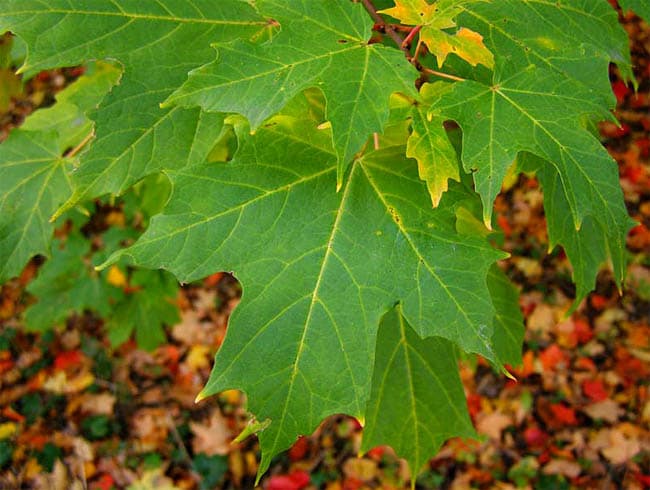Your shopping cart is empty!
Sugar maple


Acer saccharum
Sugar maple - Acer saccharum.
A desirable tree of parks and forest parks in single, group and alley plantings.
Widely distributed in the flora of North America. Grows in lowlands (but not in swamps) and up to 1600 m above sea level, on various types of soil, but better on deep, rich, well-drained. An important component of broad-leaved forests. In culture, it is quite widespread.
A slender deciduous tree up to 25 m high, with a broadly rounded or ovoid crown and grey, deeply grooved bark. Shoots are shiny, dark red. Leaves are 3-5-lobed, up to 14 cm in diameter, pointed, with rare sharp teeth, similar to the leaves of the Norway maple, but unlike it, the leaf blade is yellowish-green below.
Flowers are greenish-yellow in corymbose inflorescences. Blooms before foliage within 7-10 days. Grows slowly, very shade-tolerant, second only to beech in this indicator.
Quite frost-resistant, withstands temperatures down to -40°C.
Undemanding to soil conditions, requires the presence of potassium and carbonate salts. In urban conditions, it is sensitive to air pollution and asphalt pavement. Long-lived: lives 300-400 years. In cultivation since 1753. Seeds are stored in tightly sealed vessels or in sealed plastic bags in an unheated room. In this case, germination is maintained for up to 2 years. Laboratory germination is 75%, soil - 60%. Seeds are sown immediately after collection (shoots appear in the spring of the following year) or stratified in sand or peat for 60 days at 0 +3°C. The planting depth is 4-5 cm.
It is especially effective in autumn decoration when the leaves take on a beautiful yellow, orange and red colour.
A wonderful tree for parks and forest parks in single, group and alley plantings. It has several decorative forms: glaucous (f. glauca) - with glaucous leaves below; conical (f. conica) - with a dense, conical crown; monumental (f. monumentale) - columnar growth, with ascending branches and twigs; Rugel (f. Rugellii) - with three-lobed leaves, larger in width than in length, with entire, semi-leathery lobes, glaucous or matte-green below.
A desirable tree of parks and forest parks in single, group and alley plantings.
Widely distributed in the flora of North America. Grows in lowlands (but not in swamps) and up to 1600 m above sea level, on various types of soil, but better on deep, rich, well-drained. An important component of broad-leaved forests. In culture, it is quite widespread.
A slender deciduous tree up to 25 m high, with a broadly rounded or ovoid crown and grey, deeply grooved bark. Shoots are shiny, dark red. Leaves are 3-5-lobed, up to 14 cm in diameter, pointed, with rare sharp teeth, similar to the leaves of the Norway maple, but unlike it, the leaf blade is yellowish-green below.
Flowers are greenish-yellow in corymbose inflorescences. Blooms before foliage within 7-10 days. Grows slowly, very shade-tolerant, second only to beech in this indicator.
Quite frost-resistant, withstands temperatures down to -40°C.
Undemanding to soil conditions, requires the presence of potassium and carbonate salts. In urban conditions, it is sensitive to air pollution and asphalt pavement. Long-lived: lives 300-400 years. In cultivation since 1753. Seeds are stored in tightly sealed vessels or in sealed plastic bags in an unheated room. In this case, germination is maintained for up to 2 years. Laboratory germination is 75%, soil - 60%. Seeds are sown immediately after collection (shoots appear in the spring of the following year) or stratified in sand or peat for 60 days at 0 +3°C. The planting depth is 4-5 cm.
It is especially effective in autumn decoration when the leaves take on a beautiful yellow, orange and red colour.
A wonderful tree for parks and forest parks in single, group and alley plantings. It has several decorative forms: glaucous (f. glauca) - with glaucous leaves below; conical (f. conica) - with a dense, conical crown; monumental (f. monumentale) - columnar growth, with ascending branches and twigs; Rugel (f. Rugellii) - with three-lobed leaves, larger in width than in length, with entire, semi-leathery lobes, glaucous or matte-green below.

.jpg)










